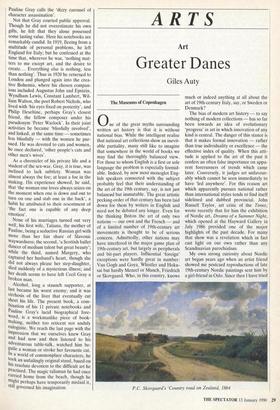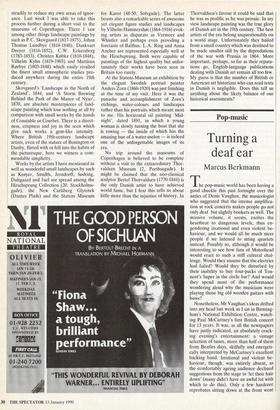ARTS
Art
Greater Danes
Giles Auty
The Museums of Copenhagen
0 ne of the great myths surrounding written art history is that it is without national bias. While the intelligent realise that national art collections show an inevit- able partiality, many still like to imagine that somewhere in the world of books we may find the thoroughly balanced view. For those to whom English is a first or sole language the problem is especially formid- able. Indeed, by now most monoglot Eng- lish speakers connected with the subject probably feel that their understanding of the art of the 19th century, say, is not just balanced but immutable. The great artistic pecking-order of that century has been laid down for them by writers in English and need not be debated any longer. Even for the thinking Briton the art of only two nations — our own and the French — and of a limited number of 19th-century art movements is thought to be of serious concern. Admittedly, other nations may have interfered in the major game plan of 19th-century art, but largely as peripherals and bit-part players. Inflbential 'foreign' exceptions were hardly great in number: Van Gogh and Goya, Whistler and Hoku, sai but hardly Menzel or Munch, Friedrich or Skovgaard. Who, in this country, knows
much or indeed anything at all about the art of 19th-century Italy, say, or Sweden or Denmark?
The bias of modern art history — to say nothing of modern collections — has so far been towards an idea of evolutionary `progress' in art in which innovation of any kind is central. The danger of this stance is that it makes formal innovation — rather than true individuality or excellence — the effective index of quality. When this atti- tude is applied to the art of the past it confers an often false importance on appa- rent forerunners of trends which came later. Conversely, it judges art unfavour- ably which cannot be seen immediately to have `led anywhere'. For this reason art which apparently pursues national rather than international styles tends to find itself sidelined and dubbed provincial. John Russell Taylor, art critic of the Times, wrote recently that for him the exhibition of Nordic art, Dreams of a Summer Night, which opened at the Hayward Gallery in July 1986 provided one of the major highlights of the past decade. For many that show was a revelation which in fact cast light on our own rather than any Scandinavian parochialism.
My own strong curiosity about Nordic art began years ago when an artist friend showed me postcard reproductions of late 19th-century Nordic paintings sent him by a girl-friend in Oslo. Since then I have tried P.C. Skovgaard's 'Country road on Zealand, 1864 steadily to reduce my own areas of ignor- ance. Last week I was able to take this process further during a short visit to the museums of Copenhagen. There I saw among other things landscape paintings by such as P.C. Skovgaard (1817-1875), Johan Thomas Lundbye (1818-1848), Dankvart Dreyer (1816-1852), C.W. Eckersberg (1783-1853), Christen Kobke (1810-1848), Vilhelm Kyhn (1819-1903) and Martinus ROrbye (1803-1848) which easily rivalled the finest small atmospheric studies pro- duced anywhere during the entire 19th century.
Skovgaard's `Landscape in the North of Zealand', 1844, and 'A Storm Brewing Behind the Park of the Manor of Nyso', 1870, are absolute masterpieces of land- scape painting which lose nothing at all by comparison with small works by the hands of Constable or Courbet. There is a direct- ness, crispness and joy in the seen which give such works a gem-like intensity. Where British 19th-century landscape artists, even of the stature of Bonington or Danby, flirted with or fell into the habits of the picturesque, here we witness a com- mendable simplicity.
Works by the artists I have mentioned as well as wonderful small landscapes by such as KrOyer, Smidth, Jerndorff, Socking, Dalsgaard and Juel are spread among the Hirschsprung Collection (20, Stockholms- gade), the New Carlsberg Glytotek (Dantes Plads) and the Statens Museum for Kunst (48-50, Solvgade). The latter boasts also a remarkable series of awesome yet elegant figure studies and landscapes by Vilhelm Hammershoi (1864-1916) evok- ing artists as disparate as Vermeer and Whistler and perhaps even providing a foretaste of Balthus. L.A. Ring and Anna Ancher are represented especially well at the Hirschsprung. Both were capable of paintings of the highest quality but unfor- tunately their works have been seen in Britain too rarely.
At the Statens Museum an exhibition by the elegant Swedish portrait painter Anders Zorn (1860-1920) was just finishing at the time of my visit. Here it was the panache and accomplishment of Zorn's etchings, water-colours and landscapes rather than his portraits which meant most to me. His horizontal oil painting 'Mid- night', dated 1891, in which a young woman is slowly turning the boat that she is rowing — the inside of which has the amazing hue of a water-melon — is indeed one of the unforgettable images of its era.
No trip around the museums of Copenhagen is believed to be complete without a visit to the extraordinary Thor- valdsen Museum (2, Porthusgade). It might be claimed that the neo-classical sculptor Bertel Thorvaldsen (1770-1844) is the only Danish artist to have achieved world fame, but I fear this tells us about little more than the injustice of history. In Thorvaldsen's favour it could be said that he was as prolific as he was prosaic. In my view landscape painting was the true glory of Danish art in the 19th century. The best artists of the era belong unquestionably on a world stage. Unfortunately they hailed from a small country which was destined to be made smaller still by the depredations of the war with Prussia in 1864. More important, perhaps, so far as their reputa- tions go, English-language publications dealing with Danish art remain all too few. My guess is that the number of British or American art historians who can read texts in Danish is negligible. Does this tell us anything about the likely balance of our historical assessments?











































 Previous page
Previous page